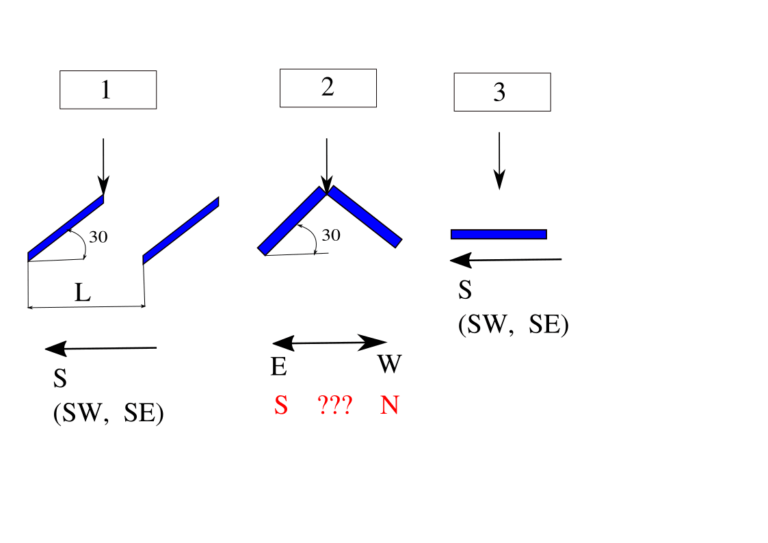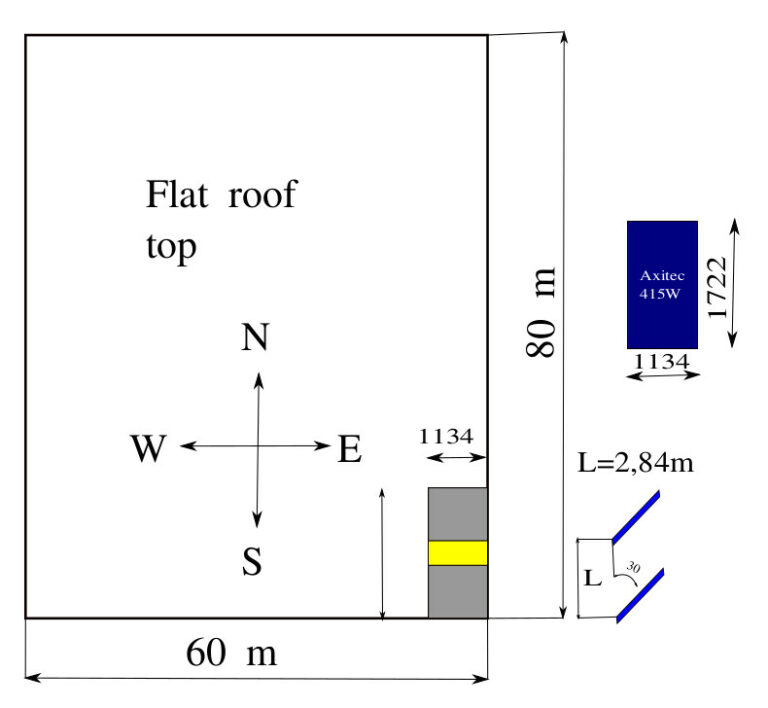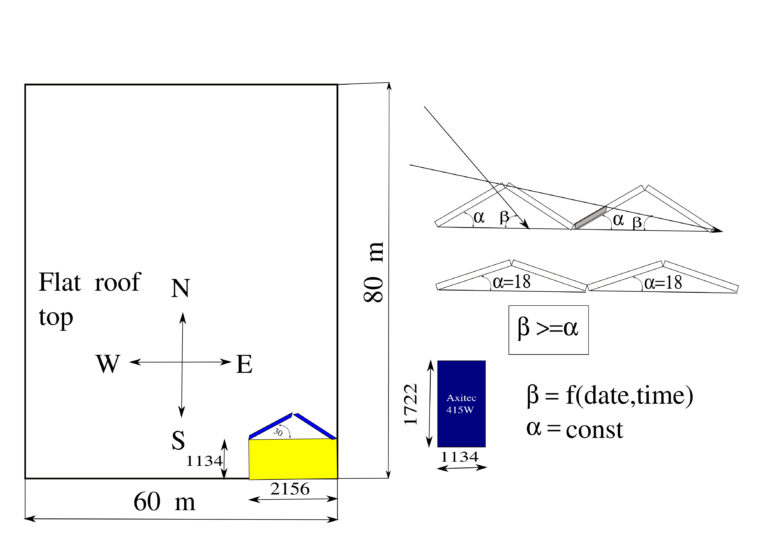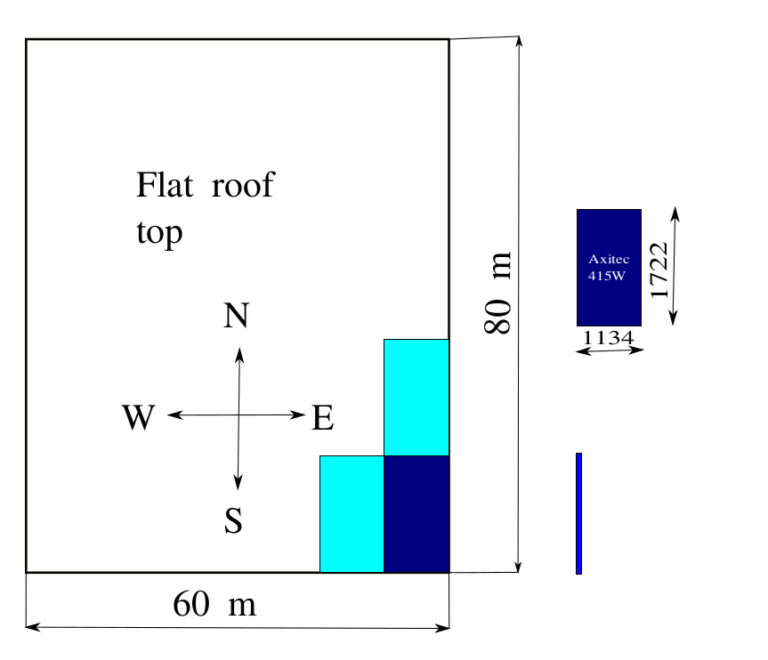Installation of solar panels on a flat roof
With the price of solar panels dropping, there are more offers to install them on flat roofs. Especially popular are the roofs of distribution centers, factory halls, megamarkets, warehouses, and cold stores. These are facilities that consume a large amount of electricity, so the economic profitability of this investment is unquestionable.
The only question is:
How to install solar panels to maximize your profits
I have seen several types of panel installation, so I will analyze all cases with the SPAC application.
1. The building is ideally oriented.
In this case, I will consider three variants, the last of which is only theoretical.
2.1 Classically placed panels as far as possible to the south
2.2 Panels are positioned on inclined supports with an east-west orientation.
2.3. Panels placed horizontally: a theoretical consideration
2. The building is not ideally oriented.
In this case, I will consider:
2.1 classic south-facing panel setup.
2.2 horizontal panel setting.We will analyze Case 2 in detail in another article.


We will choose a roof of random dimensions:
Dimension: 60 m x 80 m. Shorter side in an east-west direction
For all cases, the solar panels will be Axitec 415 W, with dimensions of 1172 mm x 1134 mm.
The current price for the calculation panel is $130.
Place of object: Los Angeles, USA
South-facing panel setting with gap due to shadow ( ground standard)
The SPAC application automatically calculates the required distance between the panels due to shadow casting. The length of the shadow varies according to the latitude. On December 21, the shadow is at its most unfavorable, measuring 2.84 meters.
D = gap due to shadow = 2.84 meters.
At a distance of 60 m, the number of columns in an east-west direction is:
M = 60 m: 1.134 m = 52.9. => 52 columns are adopted.
We calculate the number of rows according to the following formula:
N = (80 m – 1.722 m * cos(30)): 2.84 m = 27.
Total number of panels: M*N = 52 * 27 = 1404.
Now, by entering these parameters into the application, we can obtain the annual production of:
P annual = 943,868.9 kWh

The panel settings on inverted "V" supports are aligned east - west
This setup is very popular due to the current drop in solar panel prices, and it attempts to get as much energy as possible from a rooftop installation.
We place the panels on isosceles triangular supports with two equal alpha angles and arrange them east-west, so that one side of the support receives sun exposure throughout the day and both sides at noon.
With this shape, you should pay particular attention to the height of the triangle of the support, because the high height and the large alpha angle can cause the panels to cast a shadow on each other.
The altitude angle must be greater than or equal to the panel’s inclination angle.
In order to find a compromise solution, one has to look at the altitude angle in the morning hours in December and January (when there is the biggest shadow) and possibly sacrifice the energy gain in that month until 10 a.m. and after 2:30 p.m.In our calculations, we will use the angle alpha = 18.
The formula calculates the total length of one pair of panels on the support.
L1 = 2*cos(18) * 1.722 m = 2.156 m
We count the total number of pairs of panels facing east to west ( length 60 m)
M = 60 m : 2,156 m = 27.8. The addopted number is 27 rows with a pair of panels, i.e., 52 panels.
The formula calculates the total number of panels in the south-north direction:
N = 80 m : 1.134 m= 70.54; the adoption number is 70.
Total panels: M*N = 52*70 = 3640.
Compared to the first example, there are five times as many panels installed here:
We calculate the total energy according to the formula.
P = P east + P west
The power from panels facing east (before noon) is denoted as P-east. In the afternoon, panels facing west provide P-west power.We assume that P east equals P west.
The parameters used in the P east calculation are
Panel tilt angle: 18 degrees
facing south at 90 degrees
number of panels (3640): 2 = 1820
When we pass these parameters through the SPAC application, we get the following results:
P east = P west = 1,070,353 kWh.
Therefore, the total annual production is Pannual = 2,140,8,706 kWh.
This considerably surpasses the traditional on ground configuration.

on the image above:
alpha: tilt angle on a V shape
Betha: altitude angle (It depends on the day of the year, time of day, and latitude.)
Case of horizontal panel setting
I have not seen this case in practice, probably due to problems with drainage or removing accumulated snow, but I will analyze it for comparison with the previous two.
The parameters for the calculation are:
Orientation to the south: 0 degrees
Slope: 0 degrees
M*N is the number of panels that can fit on the roof.
The adopted value is 34.
N = 80: 1,134 = 70.5; we choose 70.
Total panels: M*N = 34*70 = 2380

A brief analysis of the results
First, let’s make a table for comparison.
| case | num panels | annual power(kWh) | invest($) | gain(kWh/$) |
|---|---|---|---|---|
| 1 | 1404 | 943868,9 | 182520 | 5.17 |
| 2 | 3640 | 2140706 | 473200 | 4.52 |
| 3 | 2380 | 1398621,37 | 309400 | 4.52 |
- For the first case, the best investment is 5.17 kWh per year for $1.
- The second case yields the most energy.
- The second and third cases are almost identical in terms of invested dollars and received kilowatts.In areas without snow or heavy rain, we should not ignore the third case.


